We’ve all heard of marathon pace, and seen numerous marathon pace charts, but how do you achieve your personal goal marathon pace?
What exactly are you supposed to keep in mind while picking a strategy to reach your goal time? Is one strategy or training plan preferred over another?
When it comes to your marathon pacing strategy, there are some major do’s and don’ts to consider, along with some pre-race planning that will help you finish strong.
26.2 miles is never easy.
Never.
It doesn’t matter what your marathon time is—whether you’re running a 3-hour marathon or a 5+ hour marathon—it takes guts and SMART running to get to the finish line with enough energy to smile and throw your hands up for that great race finish photo.
You can have the perfect marathon pace chart, but without the right strategy, it can all fall apart in the end.
Pacing isn’t merely a numerical game; it’s a nuanced art that requires careful calibration, adaptability, and self-awareness. Whether you’re a first-time marathoner or a seasoned runner aiming to achieve a personal best, understanding how to pace a marathon effectively can make the difference between crossing the finish line triumphantly and hitting the dreaded wall.
Science Behind Effective Marathon Pacing
I’ve always loved the data, but even more so since starting the Tread Lightly Podcast with Coach Laura Norris. She dives so deep in to the data that I always come away an even better coach from our discussions because I have more facts to back up what I was recommending.
The marathon distance, 26.2 miles (42.2 kilometers), presents a unique challenge that demands efficient energy distribution. The science of marathon pacing revolves around three primary strategies: even pacing, negative splitting, and positive splitting.
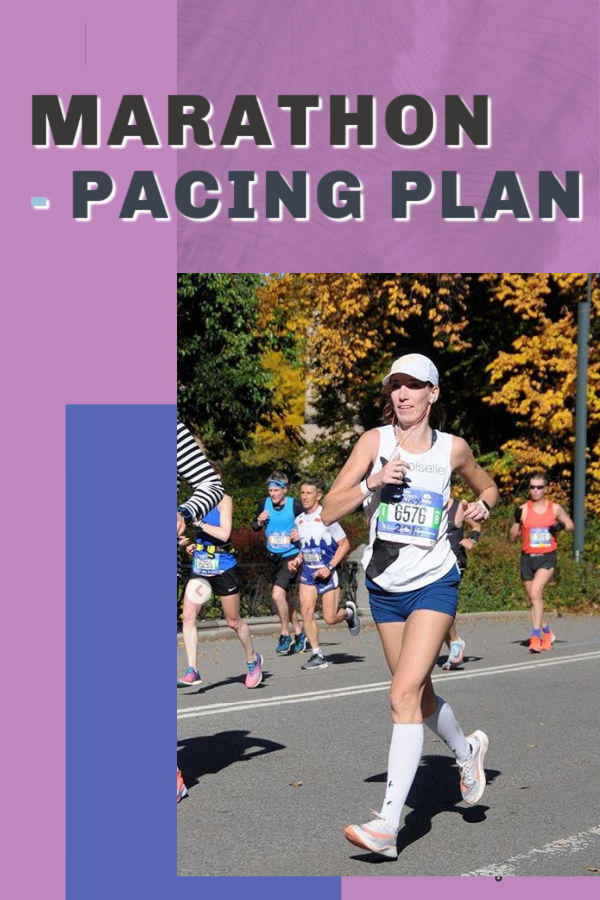
Even Pacing
This strategy involves maintaining a consistent pace throughout the entire race. By avoiding early surges and holding a steady rhythm, runners aim to conserve energy and prevent premature fatigue.
Even pacing is a prudent approach, particularly for less experienced marathoners or those aiming to secure a specific time goal. It minimizes the risk of burning out too soon, leading to a more controlled and predictable race experience.
Negative Splitting
In a negative split strategy, runners start the race at a slightly more conservative pace and progressively increase their speed in the later miles. This approach capitalizes on the body’s ability to warm up and adapt, resulting in a strong finish.
While negative splitting is often what many athletes plan for, it’s often harder to achieve because of the fatigue that builds as the miles accumulate.
Positive Splitting
Positive splitting involves starting the race at a faster pace than you intend to maintain, with the expectation of slowing down in the later stages. This strategy is risky, as it increases the likelihood of hitting the wall, experiencing excessive fatigue, and struggling through the latter portions of the race.
Positive splitting tends to generally happen by accident because we over run the early part of the race. But it may be an ideal strategy for a course that has a lot of early downhills and more climbs later.
Develop Your Pacing Plan
Crafting a well-thought-out marathon pacing plan acts as your compass, keeping you on track and preventing impulsive pacing decisions that might lead to burnout.
Here’s a step-by-step guide to developing a personalized pacing plan that aligns with your race goals and fitness level:
Step 1: Determine Your Goal Pace:
Identify the pace per mile or kilometer that corresponds to your target finish time. Whether you’re aiming for a personal best, a completion time, or a qualifying time for another race, your goal pace sets the foundation for your entire pacing strategy.
Step 2: Break the Race into Segments:
Divide the marathon into manageable segments, such as every 5 kilometers or 5 miles. Assign target split times for each segment based on your goal pace. This approach prevents overwhelming thoughts of the entire race and allows you to focus on conquering one segment at a time.
Step 3: Account for Variability:
Acknowledge that races rarely unfold exactly as planned. Factor in a buffer by setting slightly slower target paces for the earlier segments. This conservative start ensures you have energy reserves for the later stages, where fatigue might set in.
Step 4: Plan for Hydration and Nutrition:
Integrate your hydration and nutrition strategy into your pacing plan. Decide when you’ll take in fluids and fuel, and adjust your pace slightly if needed to accommodate these stops.
Step 5: Practice Your Pacing Plan:
During your long training runs, practice executing your pacing plan. Familiarize yourself with the sensation of running at your goal pace and adhering to your segment splits. This practice not only boosts your physical adaptation but also strengthens your mental discipline.
Let’s dive deeper in to some of the strategies that will help will all of this!
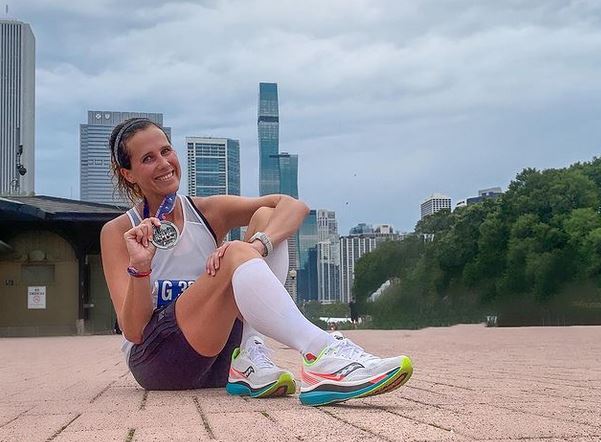
Do’s and Don’ts to Achieve the Best Marathon Pace
The key to a great marathon pace may not be what you think or even what you’ve often heard.
The tips I’m sharing with you here are ones I’ve learned for years of running numerous marathons and by being a running coach. Don’t worry, you’re in good hands!
Do: Run an Even Pace
That’s right, NOT negative splits.
Nope. That’s what articles tend to say, but I do not prescribe to that thought, nor do most elite runners.
Here’s why:
- It’s easier to find and hold a rhythm through the entire race with a consistent pace
- Going out too fast and banking time in the first half can backfire because it shoots your heart rate up early on, burning fuel, stressing leg muscles, and leading to early fatigue
- Relying on your mind and body to pick up the effort in the second half of a race when you’re fatigued is more challenging than we think
- Consider that the temperature will rise during the race, and effort increases with temp. So if you’re planning to run slower during the first half of the marathon and then pick up the pace when it already feels harder, that may be tougher to achieve.
Check out more of my pacing secrets to not rely on your watch >>
Of the 108 men’s finishers and the 149 women’s finishers for the 2016 Olympic marathon trial, only 7 individuals ran negative splits – one of whom was Meb and only by 44 seconds.
Does that even count as a negative split? It’s likely just a great finishing kick.
Most runners I know who are aiming for negative splits are trying to hack more like 10-20 seconds off per mile in the second half, and for the middle-of-the-pack, that’s asking for disaster.
What is Your Marathon Pace?
In order to utilize the even pacing strategy, it’s essential to know what your even pace should be. Training correctly will allow you to know this, so you don’t overestimate (or underestimate) for race day, because even seconds per mile add up.
Having a running coach guide you during your marathon training will also allow you to set the right marathon goal pace.
Many runners pick their even pace based on previous race times and plan to start at a pace that would bring them across the finish 5 to 10 minutes faster than their PR.
If you’re not an experienced runner, this might be risky! We all want a big PR, but unless you’ve proven in your training runs that you can hold that pace, you’re more likely to end up with a big old positive split (starting too fast and slowing way down).
Don’t: Start Too Fast or Weave
Your first smile should be your slowest.
It rarely is, but at least with that mindset, you don’t set off from the start line at a blazing pace, which will 100% catch you later in the race. You’ll burn through your carb stores super fast by spiking your HR and not allowing your body to ease into the effort.
Staying calm in the crowd and avoiding surging around other runners will pay off in the long run (pun intended).
Crowds tend to disperse between the first half mile and mile, so practice patience and start at a comfortable pace, and you’ll find your own space soon enough.
Do: Study Your Race Course
Just because I’m here telling you even pacing is ideal, doesn’t mean it’s perfect in every scenario.
Studying the course elevation profile equips you with a roadmap for how to distribute your energy throughout the race. Are there steep climbs that demand a more conservative approach? Are there descents where you can capitalize on gravity to pick up speed? Adjusting your pace accordingly can make a substantial impact on your overall performance.
Don’t Obsess Over Weather
It would be a lie to say we don’t all wish for the best possible weather on race and find ourselves stressing when it’s anything else. Since you can’t control it, what you can do is have a plan that takes the weather in to account.
Familiarize yourself with the expected conditions—temperature, humidity, wind speed—to modify your pacing plan. Hot and humid conditions might require a slightly more conservative start to prevent early dehydration and overheating.
Similarly, strong headwinds might necessitate a strategic approach to pacing during exposed sections.
Do: Learn to Manage Your Thoughts
One of my favorite running motto’s is: Set Your Mind (Not Your Watch).
Long-distance running is a mental sport. Weather, hills, nerves, etc., will play with your mind on race day. These are all factors that you cannot control.
Our ego is the loudest voice we hear during our training, and especially during the race. I call mine Margie in my book. It’s that voice that tells you that you can’t keep up. That you won’t meet your goal.
Overcoming the Negative Thoughts
Everyone experiences negative thoughts, and it’s up to you to learn to manage them. I use this tactic to overcome negative thoughts while running.
Everyone who has tried running knows that running is truly a mental sport.
You need to train your mind mentally while training your body for a race. Know that you’ll feel uncomfortable during the race and that it’s okay.
Acknowledging the fear is key to getting past the mental blocks that are holding you back from keeping your goal race pace and hitting that PR
When fear pops up, try to look at the thought with curiosity. By analyzing something from a third-person perspective, it allows us to understand things better.
You’ll realize how much you’ve trained, that you really can do it, and that you have followed your training program to make this day happen.
Deena Kastor’s book is also a great resource to help train your mind during training. The book takes you through various exercises to help you flip negative thoughts and visualize your performance on race day.
Focusing externally on what you’re doing, instead of what you’re thinking, is also a great way to break that thought pattern.
Don’t: Get Too Fixated on Your Watch
Running watches can tell us to do just about anything running-related these days. We can set a heart rate zone to stay within, a beep for certain paces and so much more….but sometimes all that data doesn’t help our performance.
If you are dead set on a goal, it’s easy to get caught up in obsessing over the numbers on your watch.
During your race, trust your body. Listen to your breathing and focus on how you feel, rather than check your pace every five seconds. This will just play with your mental game and take away your focus from your goal.
- Your pace will vary if it’s a hilly race
- You may be having a day where it all clicks and your watch could hold you back
- You may be having a rough spot and focusing on the watch will add to your stress
Do: Practice Fueling Enough
Tired of bonking during races? Then it’s time to get your fueling on point.
While bonking, i.e. running out of gas, during a race can certainly happen simply from lack of training, it’s usually due to fueling incorrectly.
All the training in the world can’t save you from yourself if you don’t take the time to learn how to hydrate, eat prior to the race, and then take in the right fuel for you during the event.
On race day, we’re pushing our bodies harder than most long runs. This means our HR is higher and we’re burning a higher percentage of carbs for fuel.
So, if we don’t keep adding fuel, our bodies will burn through it all, leaving us completely out of energy.
In turn, our brains will also try to hold us back because we’re pushing harder, and not feeding it its primary source of energy – glucose.
This is a FULL post on marathon fueling with tons of tips on using energy gels and natural fuel sources during your marathon.
How to fuel your marathon or how to fuel for a half marathon.
Do: Drink the Right Amount
Making sure you drink the right amount of liquids during the race is critical! But how much do you need to drink? For this, check your sweat rate!
To figure this out, weigh yourself before and after a long run and calculate the difference to figure out exactly how much weight you lost in fluids.
Some of us sweat more than others, and our body needs will differ from one another. So, what might be ideal for your friend, might not be best for you.
The weather on race day can also impact your fluid needs for the race. One of the major complaints for runners is the feeling of slosh while running.
Some of this is due to waiting too long to drink and then guzzling; some of it is due to trying to follow running hydration guidelines that are causing us to take in more than needed.
My ultimate guide to running hydration can answer all of those questions as well as help you pick the hydration pack that’s right for you.
Tips to Keep You on Marathon Pace
All right, now the easiest part of marathon pacing: memorizing the pace for each of the 26.2 miles you will run!
Just kidding!
There are tools for that.
Marathon Pace Bands
These handy bands place your marathon pace chart on your wrist, allowing you to quickly check your goal pace for every single mile of your marathon. They also show elapsed time for each split so you can quickly glance at your watch to make sure you’re on track.
These super cheap pace tattoos let you pick your marathon or half marathon goal and then it’s handy on your arm the whole race!
Create a Marathon Playlist
Listening to your favorite upbeat tunes on a run can certainly enhance your performance and keep you on goal.
Matching your stride to a particular beat will take the guesswork out of your pace and just allow you to focus on the sounds filling your ears.
Several playlists already exist specifically for runners, featuring songs at 180 beats per minute, or the “ideal” running cadence.
Or if you prefer to put together your own playlist, take a look at some of my favorite running songs to keep you pumped throughout the race.
Connect to a Pace Group
Most big marathons today feature pace groups to help runners with a specific time goal in mind run at a steady pace.
Pace groups are great if you want to let someone else do the thinking for you, you’re energized by running in a group, or want your own personal cheerleader throughout the race.
You’ll want to be sure to find your pace leaders before the race and talk to them about their race strategy. Knowing what to expect will prepare you for race day and help you decide if joining the group is right for you.
What’s a Good Marathon Finishing Time?
I know what you think a good marathon pace is because I watch you on Instagram thinking you’re slow, when in fact you’re very much NOT!
According to Marastats:
- The average marathon finisher is 38 years old and runs a 4:21:49 finish time with a +11:48 per mile average pace.
- Women make up 38.2% of the field with an average age of 36 and a finish time of 4:39:09 and +11m43s split.
- Men average 40 years old and finish in 4:10:10 with a +11m51s split.
- The current world record is 2:01:39 held by Eliud Kipchoge.
The top three finishers for the men’s and women’s 2020 US Olympic Marathon Trials ran the following times:
Women
- Aliphine Tuliamuk – 2:27:23
- Molly Seidel – 2:27:31
- Sally Kipyego – 2:28:52
Men
- Galen Rupp – 2:09:20
- Jacob Riley – 2:10:02
- Abdi Abdirahman – 2:10:03
Maybe your goal is to qualify for the Boston Marathon, but you’ve been nursing an annoying niggling injury throughout your training. Selecting unrealistic goals will only set you up for a race day that falls apart.
Be honest about your performance during training and your current abilities and base your marathon finish time off that.
A few things to consider when selecting a marathon race goal:
- Are you recovering from a recent injury?
- What is the race course like? Is it completely flat or full of rolling hills?
- What will the weather be like on race day?
- Do you need a coach or running group to push you past your comfort zone to nail that stretch PR time?
- How long have you been running and what is your current fitness level?
- Why are you running this race and why do you want to run a particular time?
Answering these questions will help you determine a realistic goal that is well within your reach.
How to Pick the Ideal Marathon Pace
Selecting the right marathon pace can be tricky, especially if this is your first marathon.
If you’ve run a half marathon prior to this race, then you’ll have an easier time determining your predicted marathon finish time.
One way to pick a time is to use a marathon pace calculator. You simply plug in a desired total time or finish time from a recent race, and the tool will spit out the pace per mile necessary in order to achieve that goal.
The average person should expect their marathon pace to be about 30-55 seconds slower than their half marathon pace. This number is determinant on:
- Racing experience
- Number of marathons run
- Weather conditions on race day
- Preparation for the race
While these marathon pace calculators are helpful in determining a predicted pace, they are not always so accurate, as they tend to underestimate the timing. Plus, unless you can upload the course, they have no idea how to account for terrain.
They’re good to get a general idea, but don’t rely on them to a T.
How to Improve Your Marathon Pacing
Improving your marathon pacing is about more than just choosing the right speed and sticking to it. It’s also about understanding your body, the course, and the race day conditions. So if you’re disappointed in how your last marathon went, consider these additional tips to improve your marathon pacing at your next race.
Understand Your Own Abilities
Your personal marathon pace should be based on your current fitness level and any specific goals you might have for the current race. Be realistic, and don’t set a pace that’s far beyond what you’ve been able to accomplish in your training runs.
Train on Similar Terrain
If possible, train on a terrain similar to the marathon course. If the race course is hilly, incorporate hills into your training. Understanding how your body responds to the course’s conditions will help you to pace yourself more effectively on race day.
Adjust for Weather
Weather can have a significant impact on your marathon pace. Whether it’s wind, heat, or humidity, make sure to adjust your pace to the weather conditions on race day. If you know it’s going to be a super hot day, run slightly slower to conserve energy.
Listen to Your Body
Probably the most important thing is to learn to listen to your body. While strategy and preparation is important, listening to your body’s signals during the race is the most important. If something feels off, or you feel more energized than expected, adjust your pace accordingly. Your body will tell you more than any watch or chart can.
Looking for more marathon preparation:
- Best marathon shoes
- How to fuel during a marathon
- Why not to carbo load
- Avoid marathon training burnout
- Beginner marathon training tips
- What to wear for a marathon
Other ways to connect with Amanda
Instagram Daily Fun: RunToTheFinish
Facebook Community Chatter: RunToTheFinish
Get more running tips: Pinterest
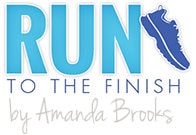
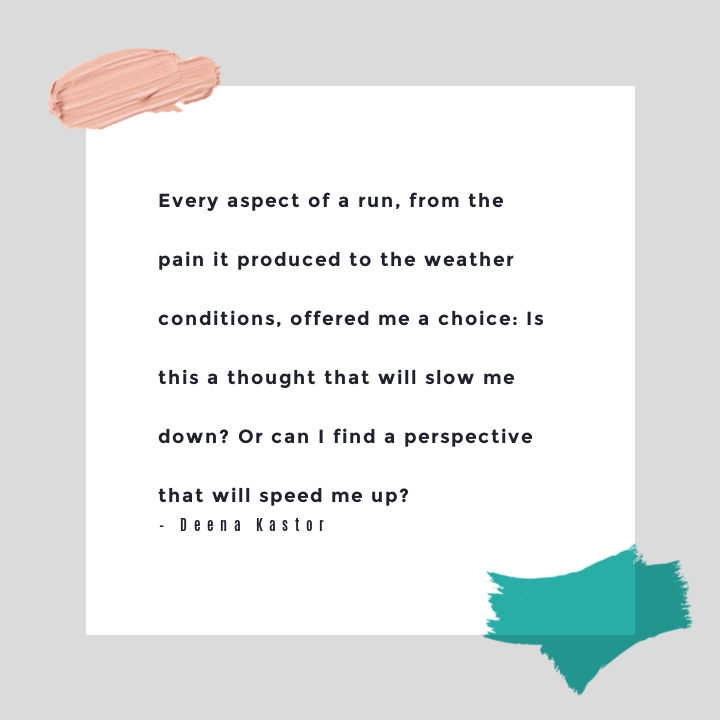
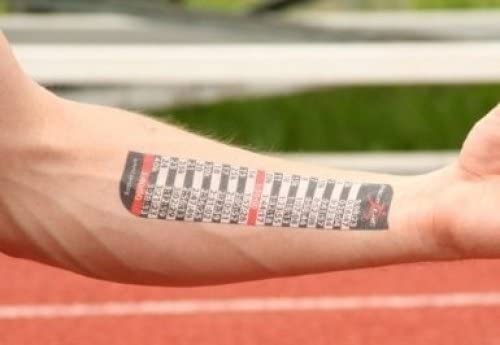

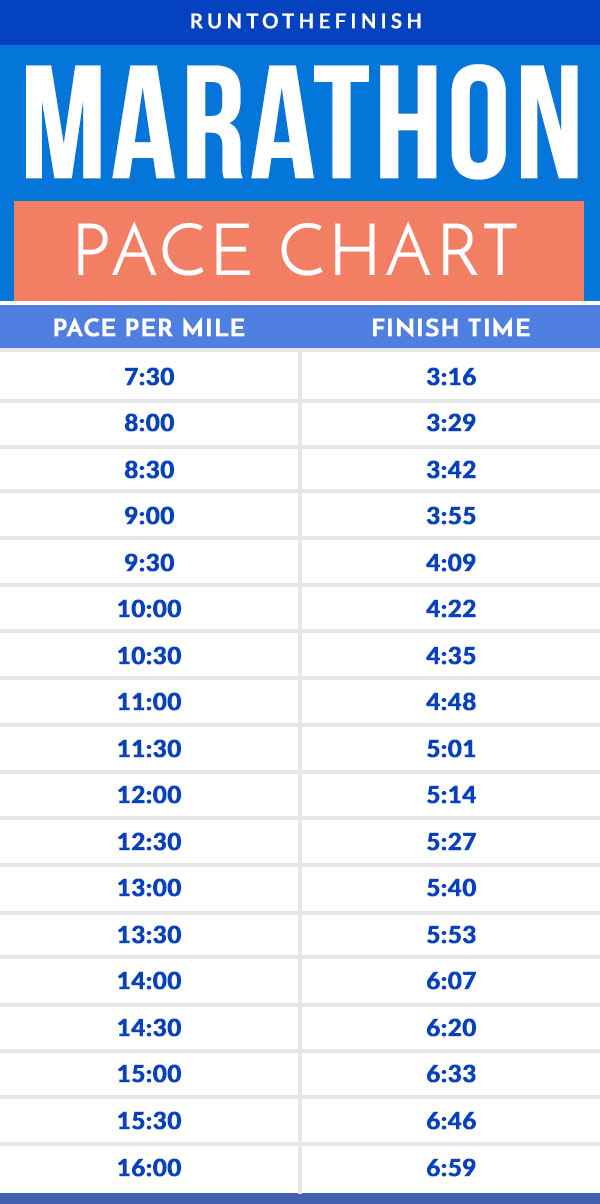

 Marathon Fuel | What to Eat, When and How Much on Race Day
Marathon Fuel | What to Eat, When and How Much on Race Day
